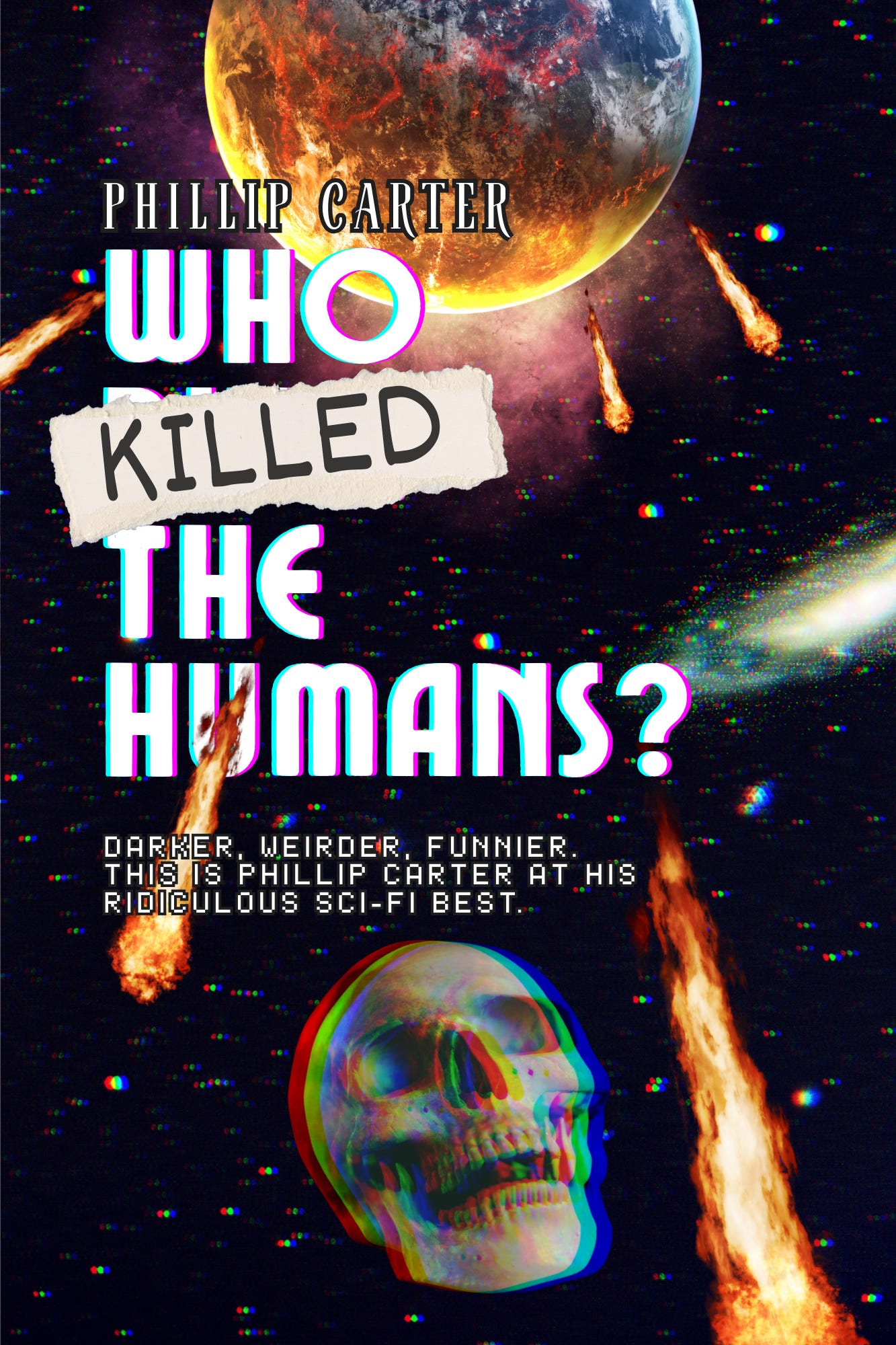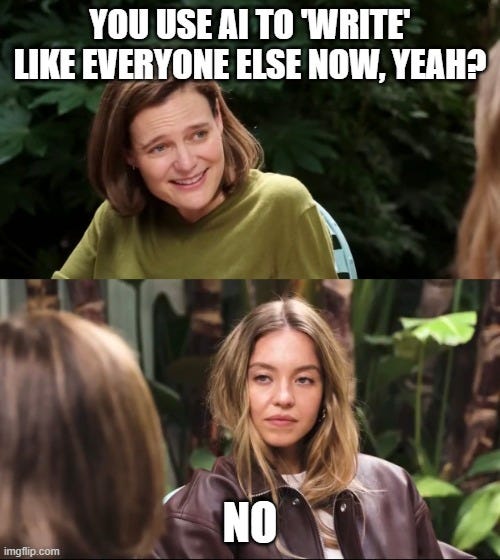On Missy's Martian Mission.
A Sci-Fi Comedy Poem about a sentient missile.
The following is from WHO KILLED THE HUMANS?
Missy the Missile is a key character, a sentient missile on a strange quest.
On Missy’s Martian Mission.
Slashing and swiping as he falls, Missy the Missile has no fears at all. He’d be feral if he had a frame of reference, he’d be too picky if they programmed in preference. He’s all about Reticulan reference, harbouring a primordial reverence for recycled reverberance, the doldrum hum of a cyclic universe on the run. It’s rattled his eye from its socket, sent shining silos into some cyborg samsara, some strange silent solitude, dude. He’s ruminated in ruins, built worldviews in wormholes. Missy’s tripping big time with no time and he’s out of time outside of time. Not following? Let me clue you in.
Missy the Missile, manufactured by mad scientist types under some monstrous, mysterious military mountain, is the perfect killing machine. As the world’s first missile with anger management issues, one might be forgiven for thinking this psychotic screw-loose (figuratively and literally) contraption, this shining cylinder of aspiring shrapnel, might operate better without neurological defects, but you’d be wrong. Missy uses his issues as a sort of backup navigational system, relying on memory long after the signal goes.
Missy the Martian-mangling missile pines for Pleiadian playmates, languishes and laments in his specially designed murder-missile hammock, complete with ergonomic blade rests and silk-lined signal jammers. Here, he’s free from freeware, secluded away from sordid software slipping its wicked words into his circuits at night. He ‘sips’ a holographic cocktail and claws a hologram kebab in his holographic universe. Shallow waves write sines on the yellow sand as shallow, sexy silos wink to him, bringing him cocktail after cocktail after cocktail. This is his good ending, and they let him dream it every time he does a good murder.
Outside this sordid simulation, drenched in blood and quenched of thirst, Missy the Missile fears the worst. He’s got too good. He meanders through the upper atmosphere, eviscerating space eels every time they come to tell us some cosmic secret. They make for good target practice, and he’s incredibly good at slicing and dicing them, so you won’t hear about them again.
Missy the missile meanders through melted Martian monuments, mapped out by manky mindreaders, prettied up before being pressed by the press. The missile is three years old and is having his first half-life crisis. Cyclops cyborg eye slips from timestream to timestream, swimming upstream to some deranged dream. Sedated psychics sleep silently in sleeping cells. Their cell phones sequestered; their families fed fictions thought up by think tanks manned by master manipulators, once mindreaders themselves, now mangled beyond recognition.
Down here on Earth nothing will ever be the same. Missy sleeps, suspended in the simulation net, murder blades twitching. He’s not been to Mars, not yet. He’s still got his training fins on. Awkward organoids nose through nebulous nightmares, navigating nebulae, archiving asteroids. His brain is straining through training. Missy sits surrounded by saddened psychics; stories slipped subconsciously into the not-quite mind of this not-quite machine, his singular eye darting in all directions, hunting for a target, hunting for purpose.
As savage machine languishes in shining solution, eviscerating imagined Martian monuments from the comfort of military mountain, Tin foil Tim slips silently between guards, distracting them with promise of signed copies of his bestselling proberotica novels. Some years prior he had been scooped by cosmic scavengers. Then, brave enough to recount the horrors, he sent his stories to serious-looking sorts in ill-fitting suits who shunted from office to office, editing out bits about orifices, turning Tin foil Tim’s nightmare scene clean, finding something shiny to glean from the obscene, then making it dirty again in a way that would sell.
Very quickly, Tim hurtled toward fame, his publisher rebranding his harrowing abduction experience as an ‘alternative romance’. Now, wallet fat with ill-earned cash, Tin foil Tim follows the rest of the money, stumbling and mumbling his incoherent way from connection to connection, finding himself at the hangar doors..
The guards, dressed in Lycra for reasons edited out of this book, are quite happy with their hardback bribes. But deep in Missy’s simulation hammock, cyborg eye stirs, slides around socket, seeks and sniffs with synaesthetic senses, snorting up slide after slide of shadowy slideshow, lightning flashes of future-memory meandering from organoid to organoid.
Missy the Missile remembers Tin foil Tim. But from when? Now, then, or another then? From whence does this rustling fellow emerge in the worldline of Missy? Can two whens make a now? If they can, when? What happens after? What happened before? Find out after this short commercial break.
END
(I have cut a bit out of this so it can’t be outright stolen by internet goblins, but enough of it was here that you might enjoy it).
Thinking about poetry
If you’re familiar with the WHO BUILT THE HUMANS series, you’ll be familiar with the fifteen Sci-Fi Comedy Poems which arrive in the first book at regular intervals, like comedy comets. They are not poems in the modern-day sense (and by that I mean they are actually poems, and not shopping lists of grievances about someone’s parents), these are big slabs of heavily alliterative stories using poetic devices to tell Sci-Fi in a weird way.
I feel uncomfortable describing them as poems (or even mentioning they are in the books) because of the stereotype mentioned above, amongst others. A lot of modern Sci-Fi readers I have met at festivals, and comedy readers at gigs, do not like poetry. I’ve even had people come up to me after poetry gigs and say “I don’t usually like much poetry, but I really liked yours” or “I am glad someone is talking about this, it was really funny.” or even “I thought poetry was meant to be depressing?” (all real quotes). This puts me in a weird position. I get to brag on Substack that the writing I wrote to entertain people, actually does entertain them, but I am something of a loner in the poetry scene. I’ve largely left it, because being a comedian who writes poems is easier than being a poet who tries jokes at poetry nights.
I can’t really tell the average person there are poems in the book because I don’t get to explain myself as I did here. Whatever horrendous experience they had with poetry in school has tainted how they expect all poetry to be, and I don’t want to tell them “but mine is good” because it’s not up to me, so I want them to encounter the poems as they are, situated in the book, and make up their minds themselves.
Their purpose of the ON SERIES poems in the original book was to provide a satirical reflection on the heavier themes, featuring gelatinous and radioactive future humans, silly time travellers, and subtle hints that Tin foil Tim, who existed solely in that universe, might meander his way outward. These silly poems are actually some of the more technically complicated writing in the book, because they needed to work with a build-your-own-adventure narrative, and on their own, and bounce off and satirise and look further into the themes in the stories around them. It made WHO BUILT THE HUMANS? into a truly multidisciplinary book, which in turn, made it hard to advertise (but readers like it).
You see, the WHO BUILT THE HUMANS? series are not just short story collections, they are living multiverses. And, in WHO KILLED THE HUMANS? (the second book in the series) you will discover that those original eleven universes are now closer than they ever were before.
One of them is even touching another one, but we won’t get into that. It’s their life, let them make their own terrible choices.
I wonder what they’ll call the baby universe.
WHO KILLED THE HUMANS? is currently 78,000 words long. The word count is jumping up and down as I edit the final few stories with my editor, and figure out the final ordering.
Because like with WHO BUILT THE HUMANS? there is a substrata of audience participation. Whilst you can read the stories as standalones, you can also play with them in an inbuilt build-your-own-adventure style narrative. This time, the choices made by a central character, through you, are what unfolds reality. You’re right in there among the aliens and the cosmic horse of doom and the sexually frustrated missile.
Fun, right?
How to get WKTH?
I will be reposting this post in a few weeks when the link is live, but a Kickstarter is in development. I want to take the launch of WKTH very seriously, so I’ve also been in contact with a few sci-fi magazines, comedy places, and Waterstones, among other retailers, for book signing events.
There are a handful of you on last year’s Crowdfundr, and that will still be honoured. In fact, I am working on a special thank-you gift for all of you who joined that early, because you joined when the project was still primordial, some before I even announced the name of the book, before I even revealed its place in the WHO BUILT THE HUMANS? multiverse.
The reason a Kickstarter is also happening is not to steamroll the Crowdfundr, but to benefit from Kickstarter’s existing audience, and to properly relaunch when the book is ready to go. The Crowdfundr was always for my fans here on Substack, which is why I didn’t heavily advertise it. Now I know what was popular, and what needs improving, before going public.
What’s in the book?
Sentient lovebots replacing their human owners
Vast alien mushrooms snorting up receptionists to get high
A mysterious horse with a universe up its bum
An alien hunting through interdimensional thrift stores for the voyager golden record
An undead man piecing himself back together across several lasagne trays and bowls
A sentient star, now reincarnated as your local drunk
A fish that is actually someone’s brother
Some very different, but still powerful, mushrooms, plotting to take over the universe
And lots more
What to expect from the Kickstarter
A 30-day period in which the book is funded, or not funded
Signed copies of both books in paperback
Potentially signed copies of both books in hardback (depends on costs)
Exclusive stickers, mini posters, and other merch
A stretch tier for audiobook production (which will also cover WHO BUILT THE HUMANS? as I still haven’t got that done!)
Signed artwork from me
Your chance to have your name in the book as a supporter
A chance to have your name in the book as a character
A chance to have your name in the book again, but as a character who dies in some stupid way
[potentially] a stretch goal for an action figure, or enamel pins
All of the above will be 100% human-designed
So, are you excited to see the Kickstarter?
Feel free to drop a comment below (or email me at fanmail@realphillipcarter.com) to make any suggestions for tiers you would like to see.
Are you a magazine editor, reviewer, TV personality, member of the press, or anything like that? Email press@realphillipcarter.com if you want to chat, I am actively looking for interview opportunities, and I have radio and TV experience, so you know I will be well behaved.
For the fans
Extra announcement. A few days back I cancelled my appearance at the Christmas Geek Fayre. That means I won’t be going, but I did order some stock before this, so signed copies of THE COSMONAUT WHO DIED TWICE and WHO BUILT THE HUMANS (6x9 inch Amazon edition) will be available online soon.
I’ve got a lot of footage from the last one (of me drawing aliens and signing books) so that will be on my author tiktok or author instagram soon.
All my writing will forever be human.
Because humans are my audience.
Not machines.







cancelled Geek Fayre for a lot of reasons, but in the cancelling I realised I've got a bit of burnout so I am working to fix this